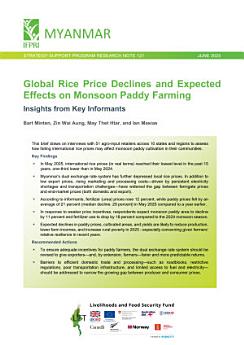Global rice price declines and expected effects on monsoon paddy farming: Insights from key informants
About this ebook
Key Findings: In May 2025, international rice prices (in real terms) reached their lowest level in the past 15 years, one-third lower than in May 2024. Myanmar’s dual exchange rate system has further depressed local rice prices. In addition to low export prices, rising marketing and processing costs—driven by persistent electricity shortages and transportation challenges—have widened the gap between farmgate prices and end-market prices (both domestic and export). According to informants, fertilizer (urea) prices rose 12 percent, while paddy prices fell by an average of 21 percent (median decline: 29 percent) in May 2025 compared to a year earlier. In response to weaker price incentives, respondents expect monsoon paddy area to decline by 11 percent and fertilizer use to drop by 18 percent compared to the 2024 monsoon season. Expected declines in paddy prices, cultivated areas, and yields are likely to reduce production, lower farm incomes, and increase rural poverty in 2025 - especially concerning given farmers’ relative resilience in recent years.
Recommended Actions: To ensure adequate incentives for paddy farmers, the dual exchange rate system should be revised to give exporters—and, by extension, farmers—fairer and more predictable returns. Barriers to efficient domestic trade and processing—such as roadblocks, restrictive regulations, poor transportation infrastructure, and limited access to fuel and electricity—should be addressed to narrow the growing gap between producer and consumer prices.








